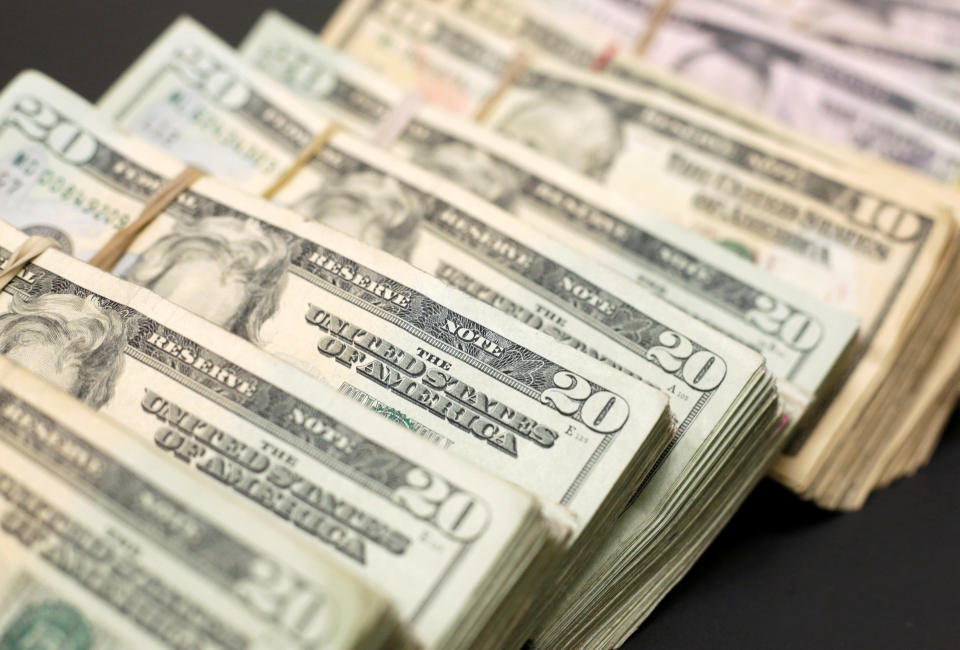Why the U.S. dollar has been tumbling

In the shadow of the stock market’s meteoric rise this year, the U.S. dollar has fallen faster and harder than most analysts expected.
The dollar took a beating in 2017, falling nearly 10%, its worst annual performance since 2003. Rather than reversing that trend as the U.S. economy grows and the Federal Reserve raises the country’s interest rates, it has continued with the greenback the weakest it’s been in more than three years compared to a contingent of world currencies used to track its value.
This has happened not just as the stock market has churned out almost daily record highs but as yields on the 10-year U.S. Treasury note have touched their highest level in three years and short-dated bonds have risen to their highest levels since around 2008. All of those things would typically back a strong dollar – one that would keep U.S. money at home and encourage overseas investors to park their money here.
But that hasn’t been the case.
Blame tax cuts
Analysts say one thing that’s driving stock, bond and currency markets in their respective directions is U.S. tax reform. The tax reform bill has equity investors excited about the windfall coming to shareholders, but it’s also expected to push the $20 trillion U.S. national debt higher. That’s driving up Treasury yields and pushing the value of the dollar lower.

“The tax cut is definitely responsible for the bulk of this (dollar weakness),” said Aaron Kohli, interest rates strategist at BMO Capital Markets in New York. “It was a huge deficit hole they were blowing and they’re doing it at a time when the U.S. economic cycle is moving and everything is going perfectly.”
The dollar initially gained as reports circulated that the tax plan would include a border tax or other offsets that would increase U.S. tax receipts. But when the final bill was delivered, it turned out to be more of a tax cut than tax reform and the $1.5 trillion price tag had traders piling into dollar-negative short positions, betting on further weakness.
Speculators’ recently raised net short dollar bets on the dollar to nearly $12 billion, according to calculations by Reuters and Commodity Futures Trading Commission data released on Friday.
As U.S. deficits rise, the country is forced to finance its debts by borrowing from other nations. That reduces the value of the dollar. There are also a number of factors luring cash out of the U.S.
Higher risk, higher reward emerging markets look attractive
The Bank of Japan and European Central Bank are expected to reduce their bond-buying program, which are pumping billions into their respective economies. And globally the economic recovery is making bonds and equities in emerging markets with high-risk, high-reward potential more attractive.
With no end in sight for the global growth story and central banks moving toward less stimulus, analysts also say they’re expecting further dollar weakness, at least in the near term.
“Until the dollar’s done losing, it’s losing,” said John Doyle, director of markets at Tempus Inc in Washington. “I’m staying the hell out of the way of it.”
While he’s also expecting the overall trend of dollar weakness to continue, Karl Schamotta, director of FX strategy at Cambridge Global Payments in Toronto, is cautioning traders that a short-term reversal could be on its way.
“We’re stacked into a huge short position on the dollar and it isn’t really all that justified,” Schamotta said. “If we have anything that triggers a rise in implied volatility in the dollar or a shock in (emerging markets)….the rise in the dollar could be very, very rapid and profound.”
—
Dion Rabouin is a markets reporter for Yahoo Finance. Follow him on Twitter: @DionRabouin.
Follow Yahoo Finance on Facebook, Twitter, Instagram, and LinkedIn.

 Yahoo Finance
Yahoo Finance 
